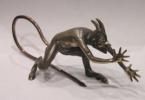The number of types of Rubik's cubes today is difficult to calculate. However, among all the variety, one can single out classic models, with images on the edges, hybrids of an unusual shape, mirror and virtual. Some models can be easily found on the shelves of the store, others can be ordered in the online store, and still others remain at the prototype stage.
Considering all the options for the Rubik's Cube, it's hard to believe that it all started with one simple model in the mid-80s of the last century. It was then in 1974 that the Hungarian sculptor Erno Rubik invented, and in 1975 patented a puzzle, which is a 3 × 3 × 3 plastic cube with 54 visible colored faces.
The original packaging of the Hungarian Rubik's Cube, 1982
The Rubik's Cube is considered the most popular toy in the world, which has sold a total circulation (original + analogues) of about 350 million copies. However, puzzles are sold all over the world under more than one name. In the original version, Rubik's invention is called the "magic cube", this name is fixed in the Hungarian, German, Portuguese and Chinese languages. In Hebrew, the Rubik's Cube is called the "Hungarian Cube".
The most popular models of the Rubik's cube
It is worth mentioning that not all puzzles presented are Rubik's Cubes. Some models were even invented before 1974, but Rubik's merit is undoubtedly their distribution.
Unique original Rubik's cube 3×3×3

3x3 Rubik's Cube World Record: 4.59
Record holder: Felix Zemdex (Australia)

World record: 1.42
Record holder: Kevin Gerhardt (Germany)

World record: 22.55
Record holder: Max Park (USA)

World record: 43.21
Record holder: Feliks Zemdegs (Australia)

World record: 1:25.10
Record holder: Max Park (USA)

World record: 2:13.12
Record holder: Max Park (USA)

World record: 35.15
Record holder: Juan Pablo Huanqui (Peru)

Meffert's pyramid (invented in 1972 before the Rubik's Cube)
World record: 2.02
Record holder: Tymon Kolasinski (Poland)

World record: 2.03
Record holder: Łukasz Burliga (Poland)

World record: 8.04
Record holder: Anuar Miguel Abib Onofre (Brazil)
Other types of Rubik's Cube
The following Rubik's Cubes are not as popular, but no less interesting. A true connoisseur of puzzles can see for himself a great option among not the most common models.



Rubik's Cube 17×17×17

Rubik's Cube 33×33×33








Rubik's Cube with drawings

Perhaps the most common misconception of the end of the last century can be considered the belief of many people that the Hungarian Erno Rubik was the inventor of the most iconic toy of the 1980s, named after him. The cube with multi-colored faces was indeed invented by Rubik, but he did not do it at all for the millions of adults and children who were trying to put together the puzzle.
An architecture and furniture design teacher needed visual aids to explain the principles of 3D planning. For this purpose, in 1974, Budapest-based civil engineer Erne Rubik created a cube consisting of 26 small cubes with multi-colored faces. Six colors of which could be in different positions. Contrary to popular belief, neither the teacher nor the students at the Budapest University of Technology and Economics sought to combine one or more surfaces of the cube from the same color.
Indeed, in order to correctly collect all six sides of the cube, you need to try 43 quintillion options.
When someone guessed that, in principle, according to the theory of probability, it is possible to assemble a six-color cube in which each surface will have its own color, even the inventor himself could not achieve this. It was rumored that for more than a month Erne twisted and turned his cube until he achieved success. And then he came up with the idea to make a children's toy out of a visual aid for students. And in 1975, Rubik patented his invention.
Without much hope for success, the cube without a name began to produce a small cooperative from Budapest. The first toys in colorful packaging appeared on the shelves of Hungarian stores on Christmas Eve 1978. However, the inhabitants of the Hungarian capital did not burn with a special desire to give friends and relatives a puzzle, which the creator himself assembled with difficulty.
In 1980, an American visiting the Hungarian capital purchased a local toy. It is not known whether he managed to assemble it on his own, but she gave birth to a wonderful idea in his head: there will be no end to those who want to try their hand if the business is put on a solid commercial footing.
As a result, representatives of the American company Ideal Toys came to Rubik and offered him to sell the patent for his invention. And only after Erne Rubik sold his invention to American businessmen, the cube became the Rubik's cube. The first products were accompanied by instructions in English, in which the following frightening text was written: “This toy develops logical thinking and stereoscopic vision in children and adults. Synchronous manipulation on many faces is a very complex task that can only be solved if the rotation logic is open.” But this did not deter potential buyers.
The Ideal Toy company conducted a marketing campaign and soon the whole world got acquainted with the Rubik's cube. In 1981, the Rubik's Cube became part of the Museum of Modern Art in New York. In the UK, a ceremony was held to present the puzzle toy to Prince Charles and Princess Diana.
In the USSR, before the puzzle began to be produced here, the Rubik's cube was most often brought from Hungary, so few people suspected that the Americans were producing the toy. Approximately 100 million real cubes and several million counterfeit products have been sold worldwide. Erne Rubik became the first legal millionaire in the socialist countries.
The author of these lines, who was a rare owner of such a shortage, was offered even 50 rubles per cube by a sultry Caucasian who flew with him on the same plane to Moscow. The scholarship for a Soviet student in the first half of the 1980s was 40 rubles a month. The student did not then sell the gift of a friendly Magyar girl, and a few months later domestic cubes were thrown onto the market.
In all countries clubs of cube lovers have been created. Popular science magazines printed tips on how to solve the cube faster, and gave step-by-step instructions on how to solve the Rubik's cube quickly and correctly. In 1982, the first Rubik's Cube World Championship was held in Budapest. The winner was Vietnamese-American student Ming Tai, who took just 23 seconds. By the way, the inventor himself was never able to assemble his offspring in less than a minute.
Subsequently, the inventor patented several more inventions: a snake and a ball. Rubik's Snake is a puzzle consisting of 24 prisms hinged to each other in the cross section of an isosceles triangle. The Rubik's Ball is a mechanical puzzle presented on February 5, 2009 at the International Nuremberg Toy Fair. Currently, Erne Rubik is involved in the development of video games, writes articles on architecture and heads the Rubik studio.
Thirty-year-old Erno Rubik in 1974 did not yet know that in a few years he would become the first official millionaire of the Eastern Bloc. Having decided to make a textbook for his students, he did not suspect that by doing so he would shock the world. The famous Rubik's Cube was supposed to explain to dull students the basics of the mathematical theory of groups. In those days, Erno Rubik taught industrial design and architecture at the Faculty of Interior Design at the Academy of Applied Arts and Crafts in Budapest.
The history of the creation of the Rubik's Cube cannot be told in a nutshell. Even the cube project took several years to mature. The original idea of the toy was made up of 27 multi-colored cubes connected to each other, i.e. designs with 156 colored faces, simplified to a set of 26 small cubes with 54 outer faces. Instead of an internal cube, there is an ingenious fastening mechanism.
Rubik's friends and students became testers. By the way, even Erno himself did not know at first how to assemble the Rubik's Cube and for the first time he did the assembly for a month.
In 1975, the idea arose to obtain a patent for the invention, which was implemented, but the first industrial batch came out only at the end of 1977. Made the first cubes in a small cooperative in Budapest for Christmas 1978 and called them "Magic Cubes". Several pieces from that batch also ended up in the USSR.
Maybe this is where the story of the creation of the Rubik's Cube ended, but the good higher forces did not allow the miraculous invention to disappear and attracted Tibor Lakzi to participate. Tibor Lakzi lived in Germany, but was of Hungarian origin, so he often visited Budapest. During one of his trips to a cafe, he saw a funny puzzle in the hands of a waiter. Laxey was fond of mathematics and at the same time was a computer entrepreneur, which is probably why he was able to appreciate the prospects of the cube and contacted its inventor. Tom Kremer, a successful game inventor who founded the company Seven Towns Ltd, was involved in the promotion of an entertaining puzzle.
Things went much better for the newly formed trio, and in 1980 the world recognized the Rubik's Cube, which was now called that way. The license for the production of the Rubik's Cube was bought by the Ideal Toy Corporation and made the first order for a million copies. The order that year had to be repeated 100 times, while even more fakes were released.
In Europe, the licensed Rubik's Cube appeared in May 1980, and in the USSR it went on mass sale in 1981. Some sources claim that the Soviet Union bought the rights to release the toy for $3 million. In the early years in the USSR, the Rubik's Cube was "gotten from under the floor" and on the recommendation of "Ivan Ivanovich". In retail trade, they often gave out no more than two pieces in one hand, so people stood in line several times, because the cube had to be in your family, given to the “right” people, etc. It got to the ridiculous - licensed cubes were given bribes to officials. And in some countries, even in restaurants, the Rubik's Cube was included in the mandatory table setting next to the salt shaker.
In those years, every tenth inhabitant of civilized countries was fond of collecting toys. There were no restrictions on age, education, social status, gender and nationality. Everyone played everywhere. The Rubik's Sandpiper has become one of the most anticipated birthday and New Year gifts. Spontaneous, and then official gathering competitions began to arise. The first champions appeared.
How to solve the Rubik's Cube interested even those who did not have it. By the way, in 1982, the Young Technician magazine published an article with illustrations and drawings, explaining in detail how to make a Rubik's Cube on your own.
In the USSR, critical articles on the topic of bourgeois and time-killing "Cubism" first appeared in the press, but they quickly dried up. Either the powers that be gave their weighty orders, or the spiteful critics were infected with the Rubik's Cube virus, but soon in the respected and significant at that time the journal "Science and Life", next to the article on achievements in space, they posted the article "How to collect the Rubik's Cube". This became a new impetus for popularization, and now mantras like ПВ2ФП2Ф1П1В1Ф1В2ФП were distributed everywhere without hesitation. And they meant - to the right, up 2 times, forward (front), etc.
So that the people who failed to collect the Rubik's Cube did not go into a binge, but somehow let out their anger, plastic hatchets were specially sold to destroy the "not going" cubes.
In Budapest in 1982, the first official Rubik's Cube World Championship was held with the participation of representatives of 19 countries that won their national championships. The winner was Minh Thai, a 16-year-old student from Los Angeles, who clocked 22.95 seconds. At the same time, there were rumors about the heroes who collected the Rubik's Cube in 10 seconds. Today, the last world record for solving a traditional cube is 7.08 seconds, which was demonstrated by the Dutch teenager Erik Akkersdijk. By the way, Eric is the champion in assembling all types of Rubik's Cubes from 2x2x2 to 5x5x5.
It was the time of the peak of popularity. Then manufacturers felt a drop in demand, but this was affected by the fact that at some point too many copies of the cubes were made, so everyone already had them. The production of Rubik's Cubes practically ceased, so the leftovers were sold in stores and since 1983 it was no longer easy to find them on the shelves.
In 1985, Tom Kremer's English firm Seven Towns bought the rights to the Rubik's Cube and resumed its production by 1991. The second wave of the "advent" of the Rubik's Cube rolled in 1996, when 300,000 copies were sold in the United States.
For reference: The Rubik's Cube was awarded the Hungarian national prize for the best invention, has repeatedly won competitions for the best toy in Germany, France, Great Britain and the USA. Since 1981, the cube has been on display at MOMA (New York Museum of Modern Art). In 1988, the International Rubik Foundation was founded, which supports young inventors.
Share success, be a man!
Thirty-year-old Erno Rubik in 1974 did not yet know that in a few years he would become the first official millionaire of the Eastern Bloc. Having decided to make a textbook for his students, he did not suspect that by doing so he would shock the world. The famous Rubik's Cube was supposed to explain to dull students the basics of the mathematical theory of groups. In those days, Erno Rubik taught industrial design and architecture at the Faculty of Interior Design at the Academy of Applied Arts and Crafts in Budapest.
The history of the creation of the Rubik's Cube cannot be told in a nutshell. Even the cube project took several years to mature. The original idea of the toy was made up of 27 multi-colored cubes connected to each other, i.e. designs with 156 colored faces, simplified to a set of 26 small cubes with 54 outer faces. Instead of an internal cube, there is an ingenious fastening mechanism.
Rubik's friends and students became testers. By the way, even Erno himself did not know at first how to assemble the Rubik's Cube and for the first time he did the assembly for a month.
In 1975, the idea arose to obtain a patent for the invention, which was implemented, but the first industrial batch came out only at the end of 1977. Made the first cubes in a small cooperative in Budapest for Christmas 1978 and called them "Magic Cubes". Several pieces from that batch also ended up in the USSR.
Maybe this is where the story of the creation of the Rubik's Cube ended, but the good higher forces did not allow the miraculous invention to disappear and attracted Tibor Lakzi to participate. Tibor Lakzi lived in Germany, but was of Hungarian origin, so he often visited Budapest. During one of his trips to a cafe, he saw a funny puzzle in the hands of a waiter. Laxey was fond of mathematics and at the same time was a computer entrepreneur, which is probably why he was able to appreciate the prospects of the cube and contacted its inventor. Tom Kremer, a successful game inventor who founded the company Seven Towns Ltd, was involved in the promotion of an entertaining puzzle.
Things went much better for the newly formed trio, and in 1980 the world recognized the Rubik's Cube, which was now called that way. The license for the production of the Rubik's Cube was bought by the Ideal Toy Corporation and made the first order for a million copies. The order that year had to be repeated 100 times, while even more fakes were released.
In Europe, the licensed Rubik's Cube appeared in May 1980, and in the USSR it went on mass sale in 1981. Some sources claim that the Soviet Union bought the rights to release the toy for $3 million. In the early years in the USSR, the Rubik's Cube was "gotten from under the floor" and on the recommendation of "Ivan Ivanovich". In retail trade, they often gave out no more than two pieces in one hand, so people stood in line several times, because the cube had to be in your family, given to the “right” people, etc. It got to the ridiculous - licensed cubes were given bribes to officials. And in some countries, even in restaurants, the Rubik's Cube was included in the mandatory table setting next to the salt shaker.
In those years, every tenth inhabitant of civilized countries was fond of collecting toys. There were no restrictions on age, education, social status, gender and nationality. Everyone played everywhere. The Rubik's Sandpiper has become one of the most anticipated birthday and New Year gifts. Spontaneous, and then official gathering competitions began to arise. The first champions appeared.
How to solve the Rubik's Cube interested even those who did not have it. By the way, in 1982, the Young Technician magazine published an article with illustrations and drawings, explaining in detail how to make a Rubik's Cube on your own.
In the USSR, critical articles on the topic of bourgeois and time-killing "Cubism" first appeared in the press, but they quickly dried up. Either the powers that be gave their weighty orders, or the spiteful critics were infected with the Rubik's Cube virus, but soon in the respected and significant at that time the journal "Science and Life", next to the article on achievements in space, they posted the article "How to collect the Rubik's Cube". This became a new impetus for popularization, and now mantras like ПВ2ФП2Ф1П1В1Ф1В2ФП were distributed everywhere without hesitation. And they meant - to the right, up 2 times, forward (front), etc.
To study the phenomenon of the Rubik's Cube, English psychologists conducted an unusual experiment. They gave the puzzle to the great apes to assemble. Chimpanzees at first reacted with extreme interest to her, but then they began to worry, anxiety turned into a strong excitement, comparable to despair.

However, similar behavior was observed not only in monkeys. According to the observations of English psychiatrists and neuropathologists, some people who fiddled with a toy in their hands for more than an hour to no avail began to get nervous, angry, people who were too unbalanced became aggressive, they had a desire to break the cube.
At the service of such expansive people, small plastic hatchets were released for sale, designed to “punish” the obstinate toy. The purchase was accompanied by instructions that said what can be done from the parts of the broken cube.
In Budapest in 1982, the first official Rubik's Cube World Championship was held with the participation of representatives of 19 countries that won their national championships. The winner was Minh Thai, a 16-year-old student from Los Angeles, who clocked 22.95 seconds. At the same time, there were rumors about the heroes who collected the Rubik's Cube in 10 seconds. Today, the last world record for solving a traditional cube is 7.08 seconds, which was demonstrated by the Dutch teenager Erik Akkersdijk. By the way, Eric is the champion in assembling all types of Rubik's Cubes from 2x2x2 to 5x5x5.
It was the time of the peak of popularity. Then manufacturers felt a drop in demand, but this was affected by the fact that at some point too many copies of the cubes were made, so everyone already had them. The production of Rubik's Cubes practically ceased, so the leftovers were sold in stores and since 1983 it was no longer easy to find them on the shelves.
In 1985, Tom Kremer's English firm Seven Towns bought the rights to the Rubik's Cube and resumed its production by 1991. The second wave of the "advent" of the Rubik's Cube rolled in 1996, when 300,000 copies were sold in the United States.
For reference: The Rubik's Cube was awarded the Hungarian national prize for the best invention, has repeatedly won competitions for the best toy in Germany, France, Great Britain and the USA. Since 1981, the cube has been on display at MOMA (New York Museum of Modern Art). In 1988, the International Rubik Foundation was founded, which supports young inventors.




